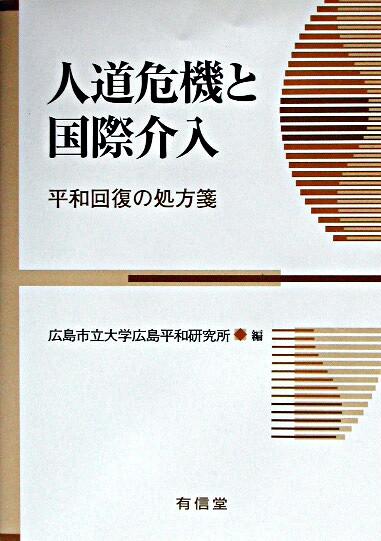
広島平和研究所/編(有信堂、2003年)
冷戦の終結によって米ソ対立という世界の安全を脅かす大きな脅威が消滅した一方で、国内紛争に伴って発生する人道危機は、人々の生活や安全を脅かす存在として大きな注目を集めるようになった。2000年7月に発足した「新介入主義の正統性と合理性に関する研究会」(プロジェクトリーダー:星野俊也・大阪大学大学院国際公共政策研究科助教授)は、コソボや東ティモールなど世界各地で発生する国内紛争に対し、国際社会がこうした危機の解決にどのように関与すべきなのか、という問題意識が出発点にあった。それ以来2年にわたって研究を積み重ねてきた成果が、2003年2月、広島市立大学広島平和研究所編『人道危機と国際介入――平和回復の処方箋』として有信堂より出版された。
本書は、「はしがき」、「あとがき」のほか11章から構成されるが、その内容は大まかに二分される。最初の4章は、国際介入をめぐる国際政治、国際法理論的な関心を中心に据えた議論を展開している。第1章は、国際社会が紛争に対して行うさまざまな介入について、国際社会における道義的な衝動と法制度と政治力学とが交わる局面における行動のあり方について整理している。第2章は、ユーゴに対するNATOの空爆を事例に引きながら、武力行使開始の「合法性」(jus ad bellum)、と手段の「正統性」(jus in bello)を峻別して介入の正当性を法的、政治的両側面から検討している。第3章は、冷戦後の紛争発生の要因をグローバリゼーションという地球規模の技術・経済・社会的再構成との関連からとらえ、いわば「内戦のグローバリゼーション」の状態を分析している。第 4章は、国家建設という国連平和維持活動に与えられた新たな役割について「国際的領域管理」という概念を導入して国際法と規範の観点から議論している。
一方、第5章以下にはさまざまなアクターの役割などに関する具体的な事例研究が収められている。第5章は、コソボ紛争におけるイタリアの人道援助と国連難民高等弁務官事務所(UNHCR)の活動を対比させながら、人道的活動の中に厳然として存在する人道主義と国益の相克とその克服の可能性について議論している。第6章は、NGOの人道支援における役割について、実務家の視点から実際の経験を交え、その限界を冷静に見据えながらも、大いなる可能性を見いだしている。第7章は、紛争報道におけるジャーナリズムの直面する課題、とりわけ紛争の公正中立な「客観報道」がいかに困難であるかを、筆者が実際に直面した事実認定をめぐる事例を挙げながら議論している。第8章では、地域機構が持つ、介入に関する規範構築の役割および、「普遍的論理」と地域の事情をつなぐ存在としての地域機構の潜在的な意義を示している。第9章は、国連平和維持活動受け入れから10年たったカンボジアの現状を分析し、国連カンボジア暫定統治機構(UNTAC)の成果と残された課題について述べている。第10章は、東チモールにおける国連の平和維持活動に実際に従事した筆者が、国連東チモール暫定行政機構(UNTAET)に課せられた政府機構の構築という新たなミッションがいかに困難なものであるのか、その課題を示している。
最後に第11章は、以上の議論を踏まえて、介入する側の公正さ、国家の安全保障だけでなく、人間の安全保障の視点を持った、正当な介入の追求が求められていると結んでいる。
[目次]
はしがき (福井治弘)
第1章 人道危機と国際介入:総論(星野俊也)
第2章 「新介入主義」の正統性:NATOによるユーゴスラビア空爆を中心に(篠田英朗)
第3章 「冷戦後の紛争」とグローバリゼーション(遠藤誠治)
第4章 国際介入の一形態としての暫定的領域管理(山田哲也)
第5章 国益と人道主義の相克:コソボ紛争におけるイタリアとUNHCR(秋山信将)
第6章 人道援助におけるNGOの活動:その役割、限界と可能性(長有紀枝)
第7章 紛争報道の現状と課題:事実認定をめぐって(土生修一)
第8章 国際介入への地域的アプローチ:介入の「正統性」と地域機構(坪内淳)
第9章 UNTACの成果と新生カンボジアの課題(水本和実)
第10章 東チモールにおける国際連合の平和維持活動:Spoiling the people, destructing the nation(東佳史)
第11章 国際介入と平和回復の処方箋(星野俊也)
あとがき (秋山信将)
Jindo kiki to kokusai kainyu: Heiwa kaifuku no shohosen
[Humanitarian Crisis and International Intervention: Formulate for Restoring Peace] (Japanese only)
Edited by Hiroshima Peace Institute (Yushindo, 2003)
The most dire threat to international security, a potential conflict between the Soviet Union and the United States, disappeared with the end of the Cold War. Since that time, humanitarian crises resulting from domestic conflicts have come to pose the greatest threat to people’s livelihood and security. Inaugurated in July 2000, the Research Project on the Legitimacy and Rationality of New-interventionism (Project Leader: Toshiya Hoshino, Associate Professor, Osaka School of International Public Policy, Osaka University), set out to explore issues raised by domestic conflicts, including those in Kosovo and East Timor, and to examine how the international community should involve itself in resolving such crises. The findings of the research conducted over the next two years were published by a Tokyo-based publisher in February 2003.
Excluding the Preface and Afterword, the book comprises 11 chapters divided roughly into two parts. The first four chapters chiefly discuss theoretical issues in international politics and law. Chapter 1 deals with the different ways the international community has intervened in conflicts, and summarizes the modus operandi that should be adopted when moral impulse, legal system and political dynamics come into play. Chapter 2, taking NATO’s bombing of Yugoslavia as its focal issue, considers the justifiability of intervention from both legal and political perspectives while making distinction between the legitimacy of resorting to the use of force (jus ad bellum) and the legitimacy of the method (jus in bello). Chapter 3 views the causes of post-Cold War domestic conflicts from the perspective of globalization――the global-level technological, economic and social re-structuralization that are taking place――and analyzes the current status of the “globalization of civil strife.” Chapter 4 looks at the new role of nation-building assigned to U.N. peacekeeping operations, introduces the concept of “international territorial administration” and examines the issue from the standpoint of international law and precepts.
The second half of the book presents actual case studies of the roles of various agents involved in interventions. Chapter 5 compares the activities of Italy’s humanitarian aid agencies in the Kosovo conflict with those of the United Nations High Commissioner for Refugees (UNHCR). It examines the conflict between humanitarianism and national interests that continues to affect humanitarian activities, and considers how the deleterious effects of the pursuit of national interests might be overcome. Chapter 6 explores the role of non-governmental organizations (NGOs) in humanitarian assistance and provides first-hand accounts of the experiences of front line workers. The chapter looks objectively at the limitations of NGOs, while elucidating their huge potential. Chapter 7 deals with issues confronting journalists when reporting on conflicts, especially the difficulty of achieving fair and impartial “objective reporting,” and draws on the author’s own experience of the problem of verifying facts. Chapter 8 points out the potential significance of regional organizations providing a model for intervention and acting as a link between “universal logic” and regional circumstances. Chapter 9 analyzes the situation in Cambodia 10 years after U.N. peacekeeping operations. It evaluates the achievements of the United Nations Transitional Authority in Cambodia (UNTAC), and examines the issues that remain unresolved. Chapter 10 outlines tasks that need to be undertaken in East Timor, where the author was involved in U.N. peacekeeping operations, and looks at the difficulties facing the United Nations Transitional Administration in East Timor (UNTAET) in creating a governmental institution.
Finally, in Chapter 11, on the basis of the findings of this project, two main requirements are singled out for successful international interventions. The first is justice on the part of the intervening party. The second is a legitimate form of intervention guided by a deep concern for human security rather than just national security.
